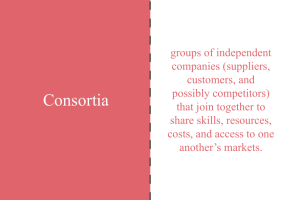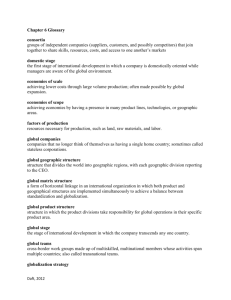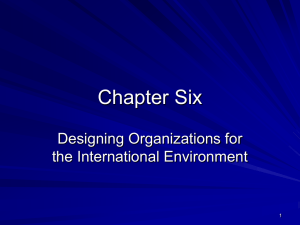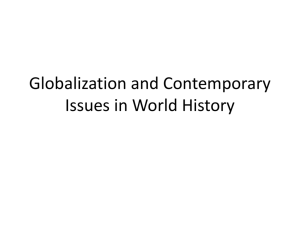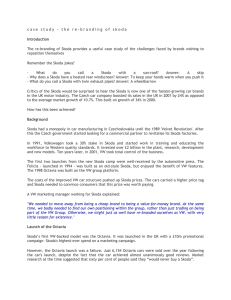Economies of Scale
advertisement
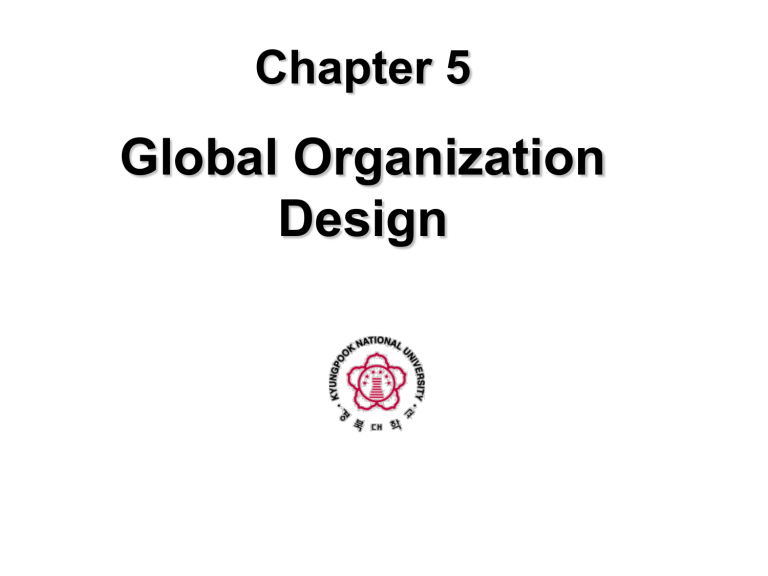
Chapter 5 Global Organization Design Motivations for Global Expansion • Economies of scale • Economies of scope • Low-cost production factors Economies of Scale • The property whereby long-run average total cost falls as the quantity of output increases Economies of Scope • Scope : the number and variety of goods and services a company offers. • Increase a company’s market power and synergy • Ex : Bancassurance Low-Cost Production Factors • Opportunity to obtain raw materials, labor, and other resources (reduced government restrictions) at the lowest possible cost. Stages of International Development • • • • Domestic stage International stage Multinational stage Global stage Domestic Stage • Domestically oriented • Managers are aware of the global environment. International Stage • Takes exports seriously • Begins to think multi domestically Multinational stage • Extensive experience in the international markets • Business units scattered around the world Global stage • Stateless corporations Designing Structure to Fit Global Strategy Global Standardization vs. Local Opportunities Globalization Strategy Products are standardized across national markets Decisions regarding business-level strategies are centralized in the home office e.g. Boeing, Intel Advantages - Economies of scale efficiencies - Save costs - Faster introduction of products - Coordinating prices - Eliminating overlapping facilities Disadvantages - Services are less suitable for globalization (advertising, marketing) - Different customs and habits throughout the countries - Economic and social changes Multidomestic Strategy Strategy and operating decisions are decentralized. Products and services are tailored to local markets. Differentiation and Customization e.g. Pizza Hut Designing Structure to Fit Global Strategy Globalization strategy: Global Product Forces for Global Integration Structure Both Globalization & Multinational Strategy: Global Matrix Structure Multidomestic Strategy: Export Strategy: International Division Global Geographic Structure Forces for National Responsiveness International Division International Division = Other major departments Export department Matrix Structure International division Domestic Divisions - Organized along functional or product lines - Lines of functional hierarchy tends to extend too long - Therefore, subdivide the org. into smaller units Product/Geographic International Divisions - Organized according to geographic interests - Own hierarchy to handle business Global Product Division Structure Standardization & Centralized Division manager’s responsibility - Planning, organizing, and controlling functions and distributions of productions throughout the world Global Product Division Structure Advantages - Economies of scale - Effective way to manage a variety of business and products - A broad perspective on competition - Respond more rapidly to a changing global environment - Can save the cost by standardizing activities and products Disadvantages - Compete instead of cooperating - Some countries are ignored by product managers - Doesn’t know what each customer wants throughout the world Globalization Strategy Global Geographic Division Structure Local responsiveness & Decentralized - Divides world into geographic region - Each division has full control of functional activities within its geographic area - Local managers (regional manager) have authority Global Geographic Division Structure Advantages Disadvantages It’s good for a company which has… It is difficult to… - Mature product lines and stable technologies - Low-cost manufacturing within countries - A strategy to customize the products to meet specific needs (for marketing and sales as well) - Plan on a global scale (R&D) - Transfer new domestic tech. and products to int’l markets - Rapidly introduce products developed offshore into domestic markets - Track and maintain control of costs - Duplication of line and staff managers across regions Multidomestic Strategy Global Matrix Structure Both Globalization and Multidomestic Strategy It works best…. - When pressure for decision making balances the interests of both product standardization and geographic localization - When coordination to share resources is important Building Global Capabilities The Global Organizational Challenge Complexity and Differentiation Increased Complexity and Differentiation • Greater level of internal and external complexity than on the domestic front • Differentiation – new positions and departments to cope with specific sectors in the environment • Meet local needs and preferences Need for Integration Integration – the quality of collaboration across organizational units Operating units can be divided by: goals, work attitudes, geographic distance, time differences, cultural values, language. Transfer of Knowledge and Innovation • Learn from their international experiences by sharing knowledge and innovations across the enterprise • Systems for sharing knowledge and innovation Main problems creating systems for sharing knowledge and innovation: • Language, culture • Managers don’t appreciate value of organizational integration, or views knowledge as power to gain influential position in firm • Knowledge is in the minds of employees Global Coordination Mechanisms Global Teams Headquarters Planning Expanded Coordination Roles Global Teams Global Teams – cross border work groups made of multi skilled, multinational members whose activities span multiple counties. Two main types: intercultural and virtual global teams. Same problems as making systems for knowledge and innovations sharing. Headquarters Planning • Headquarters take an active role in planning, scheduling and controlling of global organization. • Control through centralized systems Expanded Coordination Roles • Managers responsible for coordinating across countries • More responsibilities for functional managers Three National Approaches to Coordination and Control Centralized Coordination in Japanese Companies European Firms: Decentralized Approach The United States: Formalization Centralized Coordination in Japanese Companies • Coordination mechanisms that rely on centralization • Activities centralized in home country • Strong structural linkages • Comon to all Asia countries European Firms: Decentralized • Units have a high level of independence • Rely on strong mission, shared values and informal personal relationships • Each international unit focuses on its local market The United States: Formalization • Responsibility is delegated international divisions • Management control systems (policies, standarts, procedures) • Limited flexibility The Transnational Model of Organization Brands of European cars Volkswagen Group Skoda auto A bit of history • Established in 1895 as bike manufacture (Laurin & Klement) • 1905 first car produced • 1924 Skoda and Laurin & Klement merged • 1991 become brand of Volkswagen group • 1996 “Big change” • 2008-2009 growing during financial crisis Skoda cars today Summary What gave 19 years of being part of global organization? • 8 factories around world (Czech Republic, Ukraine, India, Bosnia and Herzegovina, Kazakhstan, China and Russia) • Recovered good name of company • Growing sales, despite economical crisis in Europe
